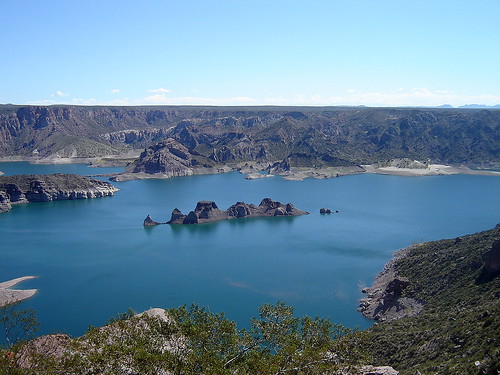
If variety is the spice, what better than a tour of the southern Mendoza. With an unparalleled range of attractions, which combine mountains, valleys, sun and water, the extreme south of the province of Mendoza is offered as an alternative both for those who captures the adventure and for the quiet walker who loves landscapes, sunrises and the sunsets that placid sleep beautifully in the Andes.
Three cities and a cluster of small villages, hamlets or places dreamed up the virtuous triangle passing through this corner of southern Manitoba: San Rafael, Malargue and General Alvear.
San Rafael, rivers and mountains:
At 960 kilometers from Buenos Aires and Mendoza 235, capital, San Rafael is a thriving enclave of service production and resting in the vicinity of rivers and Diamond Atuel always with the backdrop of the Andes. Birthplace of poets and painters, the city reserves some small surprises, like the old library and Museum of Fine Arts (with some works of Castagnino, Fader and Spilimbergo, among others), the Natural History Museum and the observatory, and parks Hipolito Yrigoyen and Mariano Moreno, the latter located on the outskirts of Rio Diamond Island, where there is a zoo.
The circuit can reach Valle Grande Canyon and the dam’s Atuel Nihuil. Leaving for Route 173 to Valle Grande, a small town of wide streets, wooded and watered by canals, take a wavy path along the river Atuel ascent, rising in the Valle de Las Lenas and runs alongside the route Canyon leads Atuel. Wedged between mountain ranges and hills is almost peeled the dam The Nihuil, an immense body of water of nearly 10 thousand hectares. Aside from being a spectacle unmatched fishing enthusiasts find their own paradise here. Also windsurfing and water skiing. Of course, swim in that frame of pristine waters and sky is an adventure in itself.

Photography by Alberto Zahor
Nearby, the Villa El Nihuil offers all the services. The Anglers’ Club, with camping, supplies, cabins and restaurant, also has swimming pool and weekend residences.
From here, after traveling 87 km. on Route 40, one arrives at Sosneado, a small town on the river Atuel, considered the starting point for cultural and adventure expeditions around the Cordillera. Along the way, you can enjoy the stunning white of the salt.
The track follows the river south of Diamante, which rises in the homonymous lagoon in the middle Andes. The lake, 34 meters deep at its edges and 70 meters in the center, occupies the crater of an extinct volcano or location of a remote glacier, which opened in the middle of a high basalt plateau at 3,300 meters above sea level. Surrounded by majestic peaks among which stands the volcano Maipo, of 5323 meters, the base is only 2,500 meters of the water body.
At 25 kilometers from San Rafael, Villa 25 de Mayo is considered a real museum, with its adobe houses and streets lined with century-old Caroline. The site, historic monument, preserved several landmarks worth visiting. Nearby, the dam’s Reyunos an interesting piece of engineering with two dams and reservoirs nearby. The former, precisely Los Reyunos, and two miles later, El Tigre, a compensatory dam. Its clear waters make excellent natural resorts for water sports and fishing.
General Alvear:
At 90 kilometers from San Rafael, General Alvear is a thriving community of 45,000 and productive importance. Watered by the generosity of Atuel river, has a pleasant, temperate climate with a tendency to cool semiarid. Near the city center, the lake’s trapal offers 45 acres of countryside with native vegetation and lakes formed by the meandering Atuel. There are also wetlands that favor the development of wildlife and sand dunes with archaeological remains. It is a place for photographic safaris and wildlife watching and ideal for extreme sports like trekking, canoeing and mountain biking. Heading towards the town of Punta de Agua, a beautiful spot surrounded by hills, woods and streams, an appeal Pozo Azul, a tributary of mineral water. Visitors come here to drink from these sources. Here also you can fish and enjoy the landscape.
Malargüe:
Located at the southern tip of the province, took an unexpected Malargüe international fame when it opened, more than two decades, the winter resort Las Lenas, but this small city’s largest department head of the province, and lying to a large part of the Cordillera to the Chilean border, offers unsuspected landscapes, waterways fascinating and unique summer weather.
Las Lenas:
Among other assignments, is essential to visit the Cave of the Witches, on the hill Moncol. Inside dazzling formations of stalactites and stalagmites up to the Board of the Virgin, a large vaulted space where thousands made their patient work. A 9 km. thence in the Rio Grande Valley, White Fences is an area of attractive landscape, fishing and paleontology.

At 68 kilometers from the provincial capital, in a natural and untouched, overlooking the lagoon Llancanelo, with his prodigious spectacle of thousands of birds. In the volcanic environment formed by the Payunia (do not miss it) and the Snowy mountains overhang the rarity and variety of wildlife, from black-necked swans to ducks, coots and herons. It is a preferred destination for many species at their long migratory journeys. The reserve, controlled by rangers, visit with company authorized guides. The place is ideal for photo safaris and bird watching, or simply to surrender to the enjoyment of nature.
Many roads and paths await you in Mendoza, Argentina.
One Response to “All the magic of tourism in the south of Mendoza”
Leave a Reply
You must be logged in to post a comment.
diciembre 16th, 2011 at 4:13 am
My photo is published in this website and there are no reference to me. Please change this error. Thank you.
http://www.flickr.com/photos/albertozahor/3405299923/in/photostream